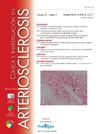代谢综合征对急性心肌梗死患者冠状动脉严重程度的影响:来自发展中国家的视角。
IF 1.9
Q3 PERIPHERAL VASCULAR DISEASE
引用次数: 0
摘要
代谢综合征(MetS)在急性心肌梗死(AMI)患者中经常被观察到。然而,评估代谢综合征对急性心肌梗死患者冠状动脉严重程度的影响的研究有限。方法:199例AMI患者行有创冠状动脉造影。本研究旨在确定MetS、MetS评分及其组成对冠状动脉严重程度的影响。结果:纳入199例符合条件的患者,平均年龄64.5±11.3岁。在整个队列中,136名患者(68.3%)被诊断为MetS。具有三个组分的MetS 3亚组的百分比最高,为29.2%。单血管、双血管、三血管、多血管疾病或左主干疾病的比例在MetS组和非MetS组之间没有差异(p < 0.05)。我们的研究显示,与非MetS组相比,MetS组的Gensini评分中位数更高(p=0.002)。此外,Gensini评分与MetS评分显著相关(Spearman相关系数为0.2)。结论:我们的研究表明,MetS、MetS评分以及MetS的两个组成部分腰围升高和血糖升高与AMI患者冠状动脉造影的严重程度相关。本文章由计算机程序翻译,如有差异,请以英文原文为准。
The impact of metabolic syndrome on coronary artery severity in patients with acute myocardial infarction: A perspective from a developing country
Introduction
Metabolic syndrome (MetS) has been frequently observed in patients with acute myocardial infarction (AMI). However, there is limited research assessing the impact of metabolic syndrome on coronary artery severity in patients with acute myocardial infarction.
Methods
We analyzed 199 patients with AMI who underwent invasive coronary angiography. This study aimed to determine the impact of MetS, MetS score and its components on coronary artery severity.
Results
The study comprised 199 eligible patients, with an average age of 64.5 ± 11.3 years. Among the entire cohort, 136 patients (68.3%) were diagnosed with MetS. The MetS 3 subgroup with three components exhibited the highest percentage at 29.2%. The proportion of one-vessel, two-vessel, three-vessel, multi-vessel disease, or left main disease did not differ between the MetS and non-MetS groups (p > 0.05). Our study revealed that the MetS group had a higher median Gensini score compared to the non-MetS group (p = 0.002). Furthermore, the Gensini score was significantly correlated with the MetS score (Spearman correlation 0.2, p < 0.05). Among metabolic syndrome components, elevated waist circumference and elevated blood glucose were associated with the Gensini score.
Conclusions
Our study revealed that MetS, MetS score and two components of MetS, elevated waist circumference and elevated blood glucose, were associated with the severity of angiographic coronary artery in patients with AMI.
求助全文
通过发布文献求助,成功后即可免费获取论文全文。
去求助
来源期刊

Clinica e Investigacion en Arteriosclerosis
PERIPHERAL VASCULAR DISEASE-
CiteScore
3.20
自引率
6.20%
发文量
44
审稿时长
40 days
期刊介绍:
La publicación idónea para acceder tanto a los últimos originales de investigación como a formación médica continuada sobre la arteriosclerosis y su etiología, epidemiología, fisiopatología, diagnóstico y tratamiento. Además, es la publicación oficial de la Sociedad Española de Arteriosclerosis.
 求助内容:
求助内容: 应助结果提醒方式:
应助结果提醒方式:


